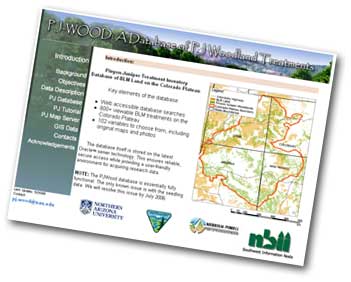Northern Arizona University, in partnership with the Bureau of Land Management and U.S. Geological Survey, has launched a new web site and online database of pinyon-juniper treatments on the Colorado Plateau.
In a three-year project, the team captured all pinyon-juniper records from Colorado Plateau BLM offices and converted the information into a powerful Oracle database built by NAU’s Information Technology Services. The database is an archive of all past pinyon-juniper removal and re-vegetation projects the BLM has completed across the Colorado Plateau. The web site is www.mpcer.nau.edu/pj/pjwood/.
“This database will be useful to researchers and land managers alike,” said Neil Cobb, director of the Merriam-Powell Center for Environmental Research at NAU. “It will allow people to ask very specific questions about treatments in their area or, alternatively, to conduct regional level analyses using hundreds of treatments.”
Cobb said the web site provides a wealth of information. It includes more than 2,000 treatment images, downloadable maps, an online mapping system and a database with 763 BLM pinyon-juniper treatments, which lets the user to choose results from 187 categories, such as temperature, rainfall and soil type.
“This data will be key to facilitating research, landscape-level analyses, and regional land management planning for pinyon-juniper woodlands, the third largest vegetation type in the U.S.,” he said.
Cobb credited the efforts of Lynn Jackson of the BLM, Keith Buhrer of NAU’s Information Technology Services, who created the database and provided web support, and Julie Prior-Magee with the USGS-Southwest Information Node, who provided additional resources.
“The project demonstrates how a multi-institutional partnership has resulted in access to information that will facilitate natural resource planning on the Colorado Plateau,” said Prior-Magee.
Efforts are currently under way to create a similar database for sagebrush treatments and should be available in about a year.



